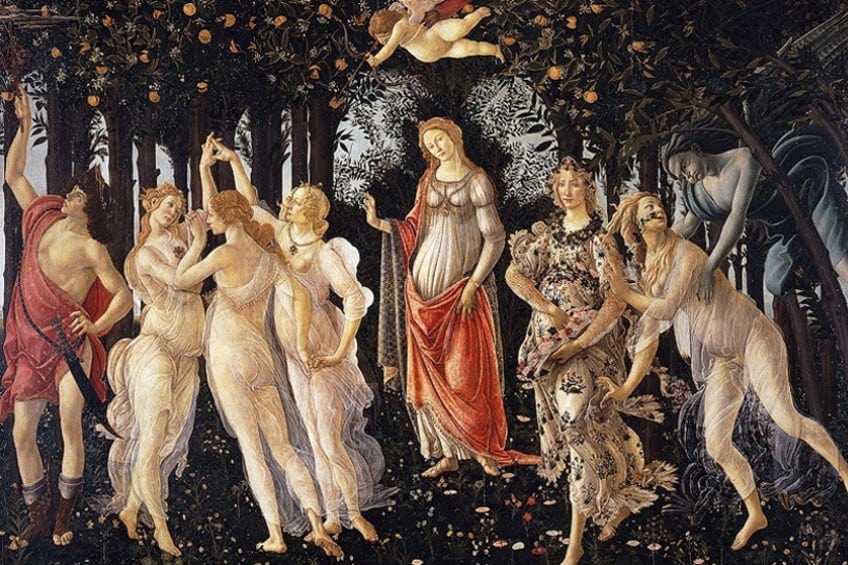“La Primavera” by Sandro Botticelli – The Iconic Tempera Painting
La Primavera by Sandro Botticelli is a large artwork that was produced using tempera paint. The Primavera painting has often been regarded as among the world’s most controversial artworks due to the lack of information regarding its original composition. Today, we shall be conducting a La Primavera by Botticelli analysis, as well as answering questions related to this artwork, such as “what does primavera mean?”. Continue reading below, as we find out all there is to know about La Primavera by Sandro Botticelli!
Contents
La Primavera by Botticelli Analysis and History
| Artist | Sandro Botticelli (1445 – 1510) |
| Date Completed | Late 1470s to early 1480s |
| Medium | Tempera on panel |
| Dimensions (cm) | 202 x 314 |
| Location | Uffizi Gallery, Florence, Italy |
The Primavera painting portrays a gathering of classical mythological figures in a garden, although no myth has been discovered regarding this particular group of beings. Although several variations of this tempera painting’s interpretation exist and many of them include Renaissance Neoplatonism (which fascinated Florentine intellectual circles during that time), most academics agree that it is an allegorical work depicting the flowering of Spring.
By 1550, Giorgio Vasari, the famous art historian, had identified the subject as Primavera (Spring) after seeing it at Villa Castello.
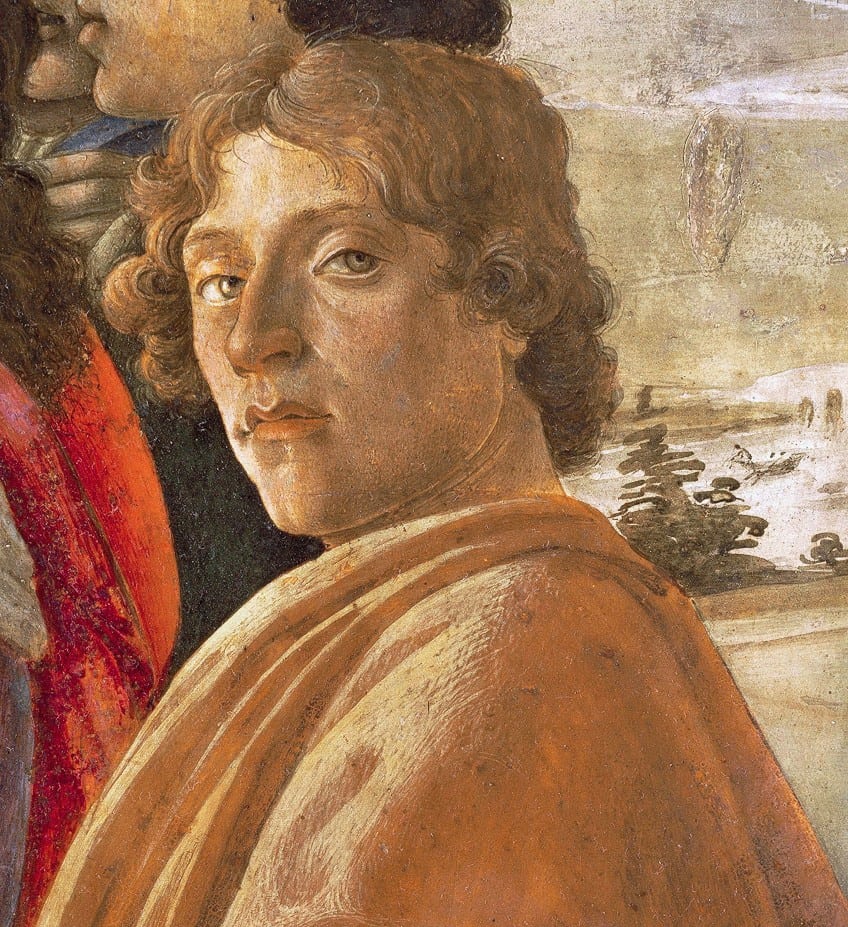
Although the two paintings are not believed to be a pair, the Primavera painting is inextricably linked to Botticelli’s other big mythological work, The Birth of Venus (1480s). They depicted topics from ancient mythology on a scale that was almost unheard of in Western art since classical antiquity.
The History of the Primavera Painting
The Primavera painting’s provenance is unknown. Botticelli was abroad in Rome for several months from 1481 to 1482, working at the Sistine Chapel, and suggested completion dates in subsequent years have generally been later, although sometimes earlier. The release in 1975 of an inventory of Lorenzo di Pierfrancesco de’ Medici’s collection from 1499 changed people’s minds.
According to the inventory, the painting was hanging in Lorenzo and his brother Giovanni’s city palace.
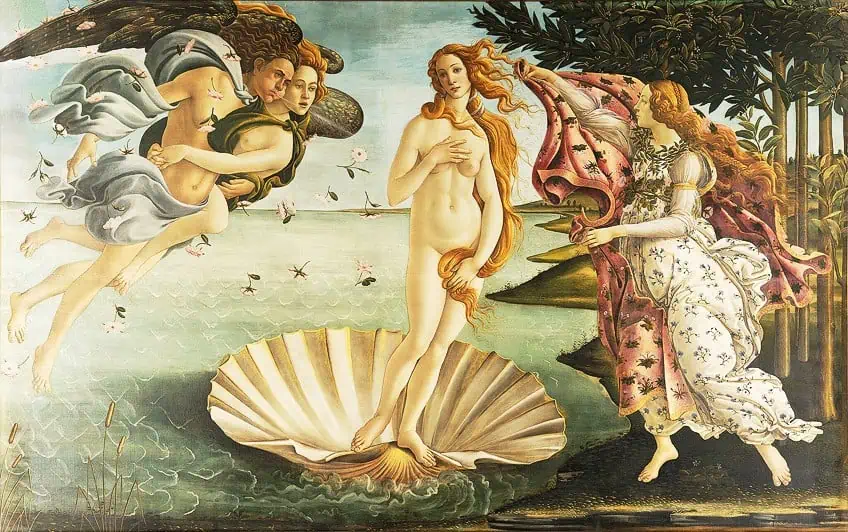
They were Lorenzo de’ Medici’s cousins, who was essentially the ruler of Florence and had been adopted by him following their father’s sudden passing. It hung over a big lettuccio (an ornate piece of furniture). The bottom of the artwork was presumably at or near the viewer’s eye level, thus it was hung higher than it is now. Giorgio Vasari stated in 1550 that he saw this work, as well as The Birth of Venus, displayed at the Medici’s Villa di Castello.
Date Theories
Prior to the discovery of the inventory, it was widely assumed that both works were created for this villa, most likely soon after it was purchased in 1477, either created by Lorenzo di Pierfrancesco or presented to him by Lorenzo de’ Medici. Most historians now associate the artwork with Lorenzo di Pierfrancesco de’ Medici’s marriage. Artwork and items of furniture often got given as wedding gifts. The wedding was scheduled for the 19th of July, 1482, but it was postponed due to the passing away of the older Lorenzo’s mother on the 25th of March, 1482.
Recent datings favor the early 1480s, upon Botticelli’s arrival from Rome, indicating that it was specifically commissioned to coincide with this wedding, a theory shared by many.

Yet another older theory, taking on an early date, suggests that the older Lorenzo requested the painting to commemorate his nephew’s birth, but changed his plans after the murder of Giulo’s father in 1478, instead having it finalized as Lorenzo di Pierfrancesco’s wedding gift. It is commonly assumed that Lorenzo di Pierfrancesco served as the inspiration for Mercury in the artwork, with his wife Semiramide representing Flora. Older theories suggested that the inspiration for Venus was Simonetta Vespucci, Marco Vespucci’s wife.
These apparent identifications rely heavily on an early date, in the 1470s, as both of these individuals had already passed by 1478.
Primavera and The Birth of Venus
This artwork and The Birth of Venus were brought together at Villa Castello and have been together ever since. They remained in Villa Castello until around 1815 when they were subsequently moved to the Uffizi. They were both stored in the Galleria dell’Accademia for a few years until around 1919. It has been displayed at Florence’s Uffizi Gallery since 1919.
During the Italian campaign of WWII, the painting was relocated to Montegufoni Castle, some ten miles southwest of Florence, so as to protect it from bombings.
The Composition of La Primavera by Sandro Botticelli
In an orange grove, the artwork depicts two masculine figures, six female individuals, and a cupid. The composition moves the eye from right to left, thus the traditional designation of the characters follows in that direction. On the far right of the artwork, Zephyrus, March’s bitter wind, abducts Chloris the nymph, whom he subsequently weds and turns into a divine being; she is transformed into the eternal bearer of life, the goddess of Spring, and is depicted spreading roses on the earth.
Chloris, the nymph, merges with Flora, the goddess she becomes. Venus appears towards the center and is somewhat offset from the other figures. She returns the viewer’s stare, similar to the flower gatherer.
To draw attention, the trees around her create a broken arch. Cupid, blindfolded, points his bow from the space above her. The Three Graces, a trio of girls dressed in white, dance on the left side of the image. Mercury, dressed in red and carrying a sword, lifts his wooden rod toward thin gray clouds on the far left. The interactions of the figurines are unclear. Chloris and Zephyrus exchange glances. Venus and Flora are looking at the observer, Cupid is blinded, and Mercury is turning his back on the rest of those present and is staring up at the clouds in the sky. The middle Grace appears to be looking at him, while the other two appear to be looking at each other.
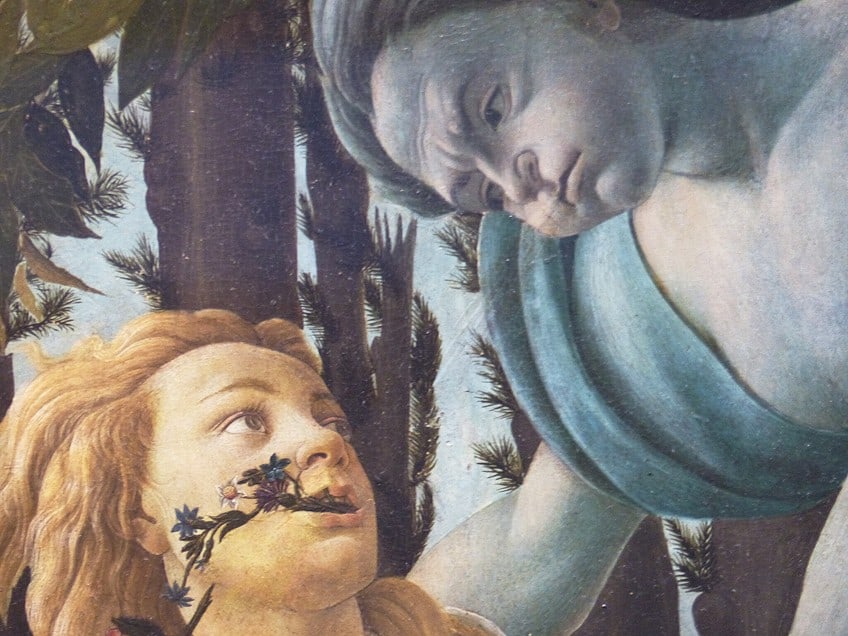
Flora’s smile was unheard of in painting at the time. The rural environment is detailed – the artwork depicts 190 distinct blooms, at least 130 of which may be properly identified. The general design and grandeur of the image are akin to “thousand flowers” Flemish tapestries, which were popular palace decorations during that period. By the 1480s, these tapestries weren’t keeping up with the aesthetic innovations of the Italian Renaissance, and the arrangement of the painting reflects the enduring Gothic style.
The figurines are “positioned side by side as pearls hung on a piece of string” in a basic line across the painting.
The bottom of the painting was positioned roughly at eye level, or just above it, in the location for which the artwork was designed, which helps to explain “the slowly rising plane” on which the characters stood. Venus’s feet are significantly more elevated than those of the other people, indicating that she is behind them, although she is on the same scale, if not slightly bigger, than the other characters in the painting. Chloris’ hands and Mercury’s sword overlap the other individuals in the painting, revealing that they stand somewhat in front of Flora and the left Grace.
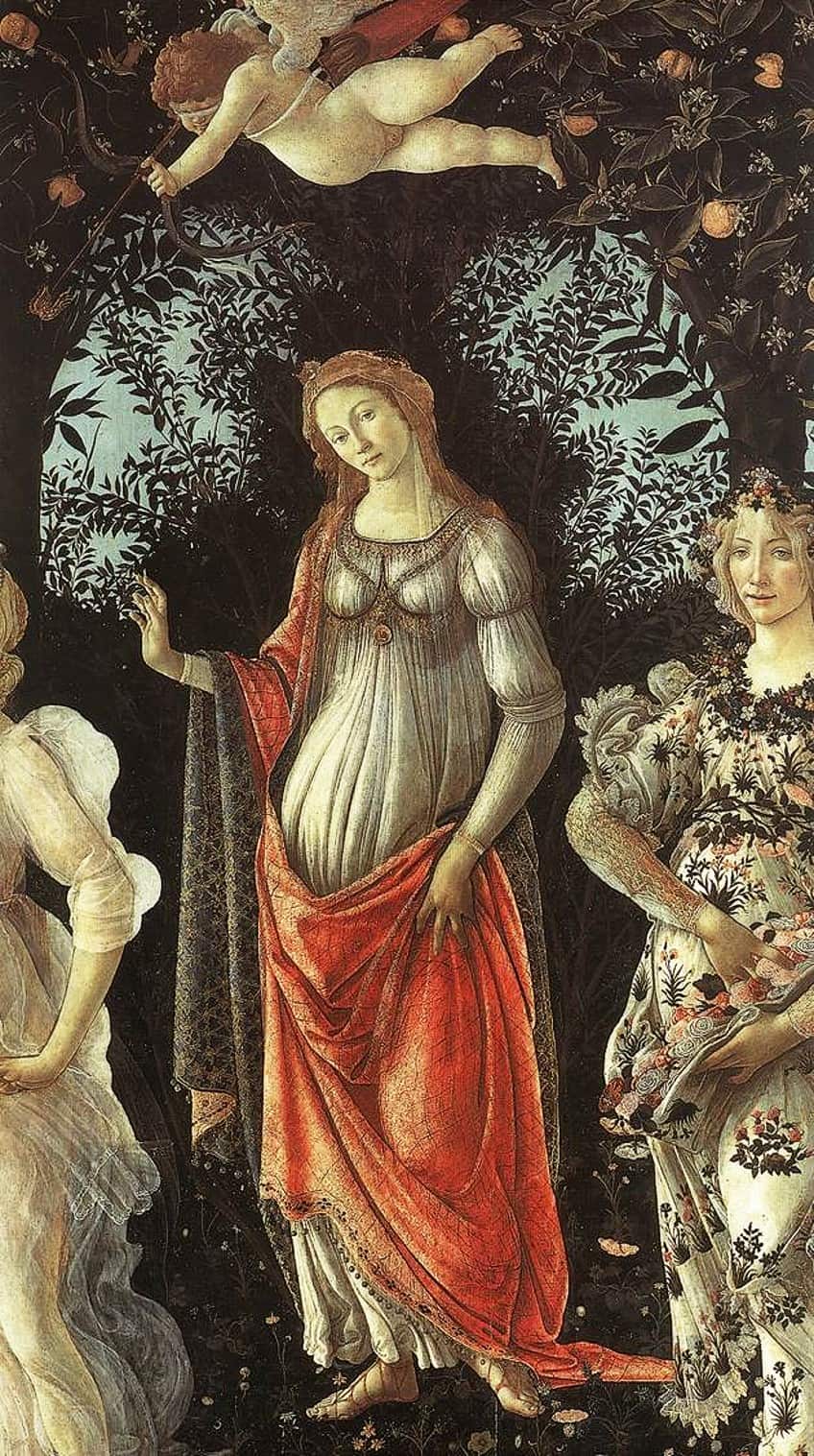
It has also been pointed out that the flowers do not become smaller towards the back of the artwork, which is a characteristic of millefleur tapestries. The characters’ outfits are modern Florence versions of “quasi-theatrical garments created for masquerades of the kind that Vasari reported were created by Lorenzo de’ Medici for tournaments and civic festivals.”
The absence of a clear narrative could be attributed to the realm of pageants as well as often unchanging Gothic allegories.
Primavera by Botticelli Analysis
Various interpretations of the individuals have been proposed, but it is widely recognized that the artwork represents, “a complex mythological allegory of the flourishing fertility of the planet”. Botticelli is assumed to have had assistance with the composition of the work of art and whatever significance it was meant to express, as the work of art appears to represent a deep understanding of ancient philosophical and literary works that Botticelli seems unlikely to have known. Poliziano is often assumed to have been involved, although Marsilio Ficino, a significant figure in Renaissance Neoplatonism, has also been suggested.
One component of the Primavera painting depicts the progression of the spring season. Early Spring’s wind blows on the land, bringing about vegetation and blossoms, overseen by Venus, with Mercury, the deity of May in the ancient Roman calendar, on the left, driving away the last clouds preceding summer.
Mercury, in addition to being part of a seasonal cycle, is functioning as the garden’s security, which explains his military attire and facing out of the pictorial space. In Virgil’s Aeneid, he is described as cleansing the heavens with his caduceus. Clouds, according to Neoplatonists, are “the beneficent veil through which the splendor of divine truth can reach the observer without harming him”.
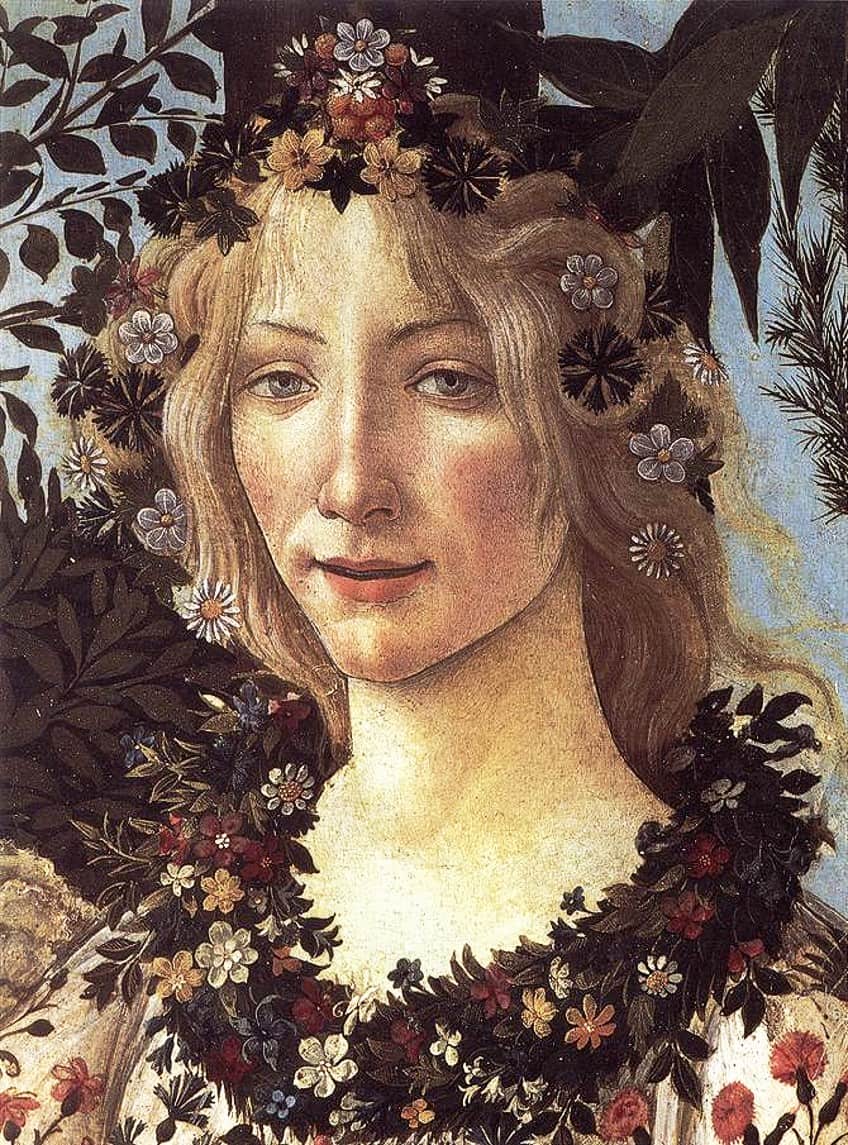
Venus rules over the garden, which includes an orange grove. It is also the oasis of the Hesperides of ancient myth, from whence the golden apples featured in the Judgement of Paris originated; the Hellenistic Greeks determined that these were exotic fruit from citrus trees. Venus poses in front of a myrtle bush’s black foliage. According to Hesiod, Venus was born from the sea after Uranus’ sperm fell into the waves following his castration by Chronos. Coming ashore in a shell, she wrapped herself with myrtle, and the herb grew sacred to her.
Venus is depicted in the painting as the goddess of marriage, dressed modestly and with her hair discreetly veiled, as wedded women were supposed to dress in public.
The Three Graces are actually mythological sisters who usually accompany Venus. They are ordinarily naked and remain stationary while they clasp hands in ancient art, but this depiction is quite similar to one by Leon Battista Alberti in his De Pictura (1435), which Botticelli would have known about. Pleasure, Chastity, and Beauty are arranged from left to right in the painting.
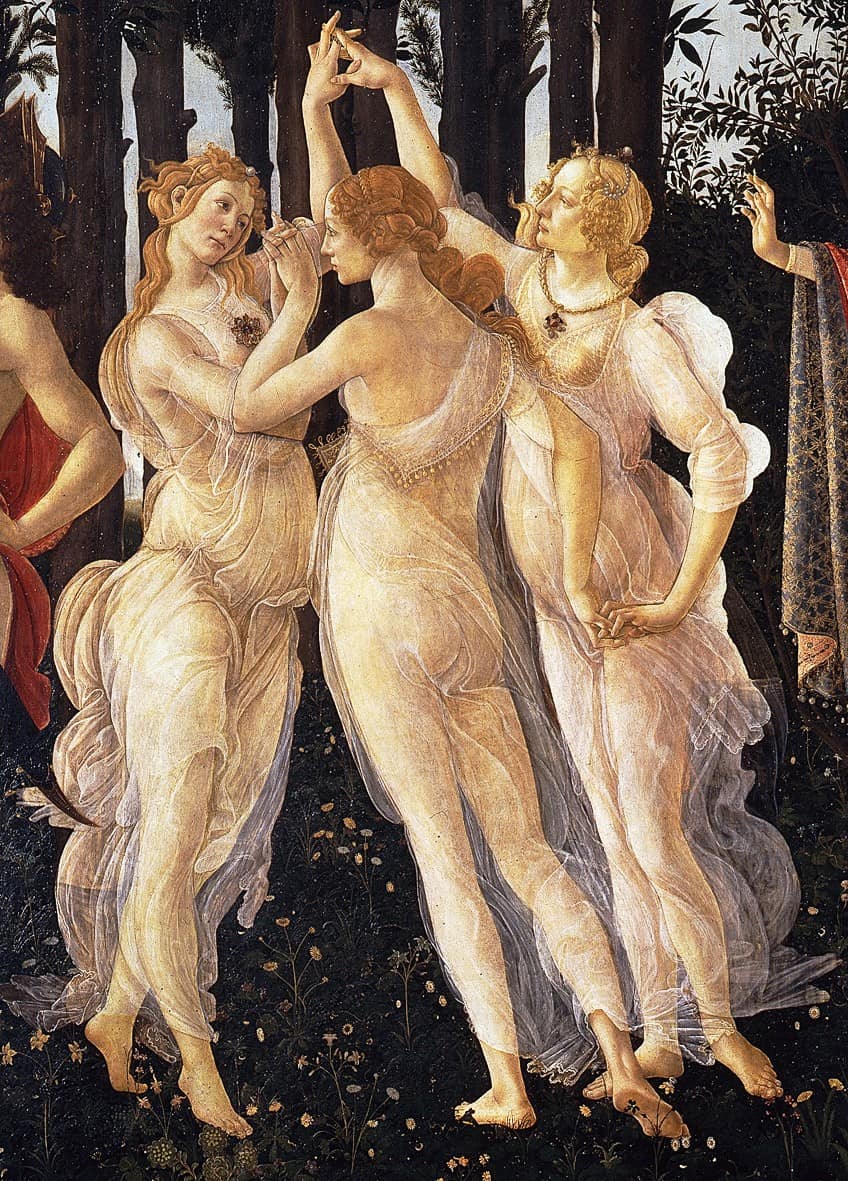
According to Wind, Cupid’s arrow is targeted towards the middle Grace -Chastity – and the influence of passion on chastity, which results in marriage, is included in numerous interpretations. Chastity glances at Mercury, and certain interpretations, particularly those who identify the characters as being based on real people, regard this couple as a match for Zephyrus and Chloris on the opposite side of the artwork. Another interpretation shows the main figure of the Graces turning her back, unconcerned by Cupid’s threat, abandoning the Earthy carnal desire symbolized by Zephyrus to the right.
The identification of the individuals is now universally accepted, but various names have been employed in the past for the women on the right, who represent two phases of the same person according to the traditional interpretation.
Primavera may be the lady in the flowery attire, with Flora the figure chased by Zephyrus. In 2011, one academic proposed that the central character is Persephone instead of Venus. In addition to its obvious interpretation, the artwork has been understood as a representation of the ideal of Neoplatonic love espoused by Marsilio Ficino among the Medicis and their supporters.
That completes our look at the tempera painting, La Primavera, by Sandro Botticelli. What is unique about this artwork is that it does not relate to any known mythological story or legend. Instead, it seems to be a novel tale of the arrival of Spring. No matter its intended subject matter, it continues to be one of the most well-known paintings from human history, along with another painting that has accompanied it for many centuries, The Birth of Venus.
Frequently Asked Questions
What Does Primavera Mean?
Primavera is an Italian term that translates into spring in English. It describes the season that follows the cold winter months. The word is used in a number of situations, including art and music, to inspire feelings of regeneration, expansion, and energy associated with the spring season.
Who Painted the Primavera Painting?
The Primavera painting was a large artwork produced using tempera paint by Sandro Botticelli. You may recognize his name from his other famous work, The Birth of Venus. In fact, these two paintings have been kept together now for many years and both currently reside at the Uffizi Gallery in Florence, Italy.
Jordan Anthony is a Cape Town-based film photographer, curator, and arts writer. She holds a Bachelor of Art in Fine Arts from the University of the Witwatersrand, Johannesburg, where she explored themes like healing, identity, dreams, and intuitive creation in her Contemporary art practice. Jordan has collaborated with various local art institutions, including the KZNSA Gallery in Durban, the Turbine Art Fair, and the Wits Art Museum. Her photography focuses on abstract color manipulations, portraiture, candid shots, and urban landscapes. She’s intrigued by philosophy, memory, and esotericism, drawing inspiration from Surrealism, Fluxus, and ancient civilizations, as well as childhood influences and found objects. Jordan is working for artfilemagazine since 2022 and writes blog posts about art history and photography.
Learn more about Jordan Anthony and about us.
Cite this Article
Jordan, Anthony, ““La Primavera” by Sandro Botticelli – The Iconic Tempera Painting.” artfilemagazine – Your Online Art Source. June 28, 2023. URL: https://artfilemagazine.com/la-primavera-by-sandro-botticelli/
Anthony, J. (2023, 28 June). “La Primavera” by Sandro Botticelli – The Iconic Tempera Painting. artfilemagazine – Your Online Art Source. https://artfilemagazine.com/la-primavera-by-sandro-botticelli/
Anthony, Jordan. ““La Primavera” by Sandro Botticelli – The Iconic Tempera Painting.” artfilemagazine – Your Online Art Source, June 28, 2023. https://artfilemagazine.com/la-primavera-by-sandro-botticelli/.


